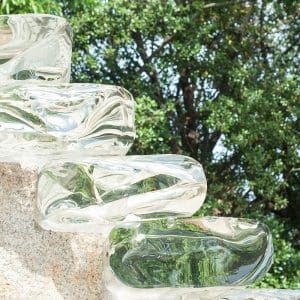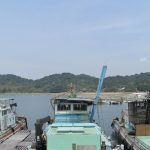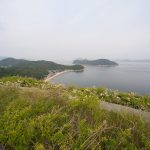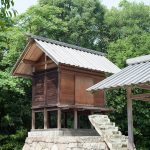On Being in Love with Concrete, Wood, Water, Stone, Glass

Yayoi Kusama, Pumpkin
Last May, I visited Naoshima, a small island in the Seto inland sea in Japan. The island has a population of 3,600 or so, in an area a little over 8 square kilometers. Many of the residents are laborers in the Mitsubishi Materials Smelter and Refinery, a large industrial complex spanning the northern part of the island. To the south, there are three small villages, including Tsumuura, a long-time fishing port,and Honmura, a castle town founded in the 16th century.
But I didn’t go for the castle. Since the late 1980s, Naoshima has been developed as Japan’s “art island”—it is home to three museums, dozens of site-specific installations, and an ongoing collaborative project between artists and the Honmura civic council to transform abandoned buildings in the village. I went to Naoshima to be immersed in art. I stayed there, with my husband and three dear friends, for two nights and most of three days—though time there is difficult to judge, and in my memory it is simply one extended exhale.
Our rooms were in the Benesse House Museum part hotel, part gallery. The museum’s collection is remarkable: Andy Warhol, Cy Twombly, Donald Judd, Yayoi Kusama, Gerhard Richter, Shinro Ohtake, Richard Long, Nam June Paik, Yukinori Yanagi, Gilbert & George, Hiroshi Sugimoto. Each guest room was a private gallery, too: we slept beneath Josef Albers’ White Line Square; a Sol Le Witt hung in our friends’ room. In the evening, after the museum closed to visitors, we padded down the hall in Benesse-issued sleeping shirts and slippers to watch Bruce Nauman’s 100 Live and Die flash “Sing and Live,” “Kiss and Die,” “Play and Die,” “Fail and Live,” and on and on in neon poetry for an hour or so before bedtime.
This private access was thrilling, but I’m not writing this to show you my vacation slides. I want to tell you about falling in love with light and paint and glass. I want to share some moments of abandon. I can’t think of another way to say it: on Naoshima, we were in the art. Each museum, each installation, is meticulously arranged and carefully sited to put artwork, beholder, light, and environment not only in conversation, not only in proximity, but in an overwhelmingly sensuous intimacy.
Intimacy, proximity, conversation—that is the very stuff of Cai Guo-Qiang’s Cultural Melting Bath, an outdoor installation of Taihu rocks, hot tub, and herb-infused bath water. Since 1997, Cai has exhibited several Cultural Melting Baths (subtitled “Projects for the 20th Century”) in China, Europe, and the US; Naoshima’s is a permanent exhibition, arranged in a clearing between museum-hotel and beach.
We’d made an advance appointment to visit the installation, and we picked our way down the hot, rocky path. There were three of us, together, and two others, strangers: one from Beiruit and one from London. I couldn’t help thinking, art historically, that we were part of one of those macrocosmic Chinese landscape paintings, and at the same time set into a fantastically oversized garden of gōngshí, or Scholar’s Rocks. The 36 stones of the Cultural Melting Bath come from Donting Mountain near Lake Tai, Jiangsu—and because of the action of surging water on limestone, the rocks, over time, become open, porous. They change their form, slowly, through interaction. It is a dynamic, transformational process, unfolding. We had booked an hour at the Bath, though we stayed nearly two, the initial awkwardness of sharing the tub, and bathing suits, and languages, with strangers dissolving in heat and water.
The most intense emotional experience on the island came for me in the Chichu Art Museum—a fantastically stark concrete bunker by the architect Tadao Ando.
Each of the four spaces of the Museum is custom built to harmonize with a specific artwork; in that particular room, five huge paintings from Monet’s Water Lilies series float on white walls, over a white floor. (We trade our shoes for slippers at the entrance, and can only enter a few at a time.)
The point here is natural light, diffused from a shaded skylight. And here is where art historical writing fails me, and I long for a better training in ekphrasis. I walked into that room, and I burst into tears. Silent, streaming tears, and a feeling of both physical and metaphysical lightness I’ve only had in dreams, or deep underwater. My reaction startled me. I’d seen Water Lilies dozens of times; shit, I don’t even like Impressionism. But then, there: I did. I loved it. Because the light, the walls, the space, the scale—they made the paintings glow. The Water Lilies became three-dimensional. Not in a “painterly” way, not in an “I can see the brushstrokes” way. In an Op-Art, cross-your-eyes, Avatar-in-IMAX way. The canvasses were on each wall. And I was in the middle of a garden of water lilies. In the middle of a garden of water lilies.
I looked over at my husband, at my best friend. We were all crying.
That art can affect us, affect me, so profoundly when we simply look at it shouldn’t surprise me. But it still does.
For this post, I had intended to share some of the artworks that most interested me on Naoshima, works that I found particularly satisfying both visually and intellectually. I had intended to write about Hiroshi Sugimoto’s photograph framed and embedded in the cliff face above the island’s shore, left to elemental transmutation.
I planned to consider how the distance, the impossibility of seeing the work, creates longing for an imaginary object that is ultimately absent and irretrievable; the subjective experience thus reframes the material processes of photography, and plays on both time and exposure.
I intended to compare this to another Sugimoto installation, Appropriate Proportion, across the island in Honmura. Sugimoto restored the main, Edo period building at the the Go’oh Shrine, and added a new viewing pavilion and rock garden.

It remains a shrine, a devotional site in which the materials themselves seem to be the objects of veneration. The crystal steps leading up to the Main Sanctuary are made of optical glass, like that used in camera lenses.
And so I intended to write that this makes us aware not only of Sugimoto’s role as photographer, but of the slipperiness of vision, and perhaps even of the play of illusion, transparency, and transcendence in religious “seeing” itself. If Cai Guo Xiang’s works on Naoshima are about touch, community, and interaction, then Sugimoto’s seem to be about vision, distance, and desire.

I had intended to write about the artworks of Naoshima in this way, sharing my impressions, interpretations, discernments. And in doing so, my goal was to practice closing that gap between ‘writing about materiality’ and ‘writing about history’ — a gap held open, as James Elkins has noted, by habits of art historical writing and thinking. I still want to practice that, write that. And I will. But here, I realize I can do something that other publishing formats won’t quite allow. I can show you. I can show you what affected me, what made my heart gasp and my breath beat on Naoshima: the small places where one material rubbed up against another. Where light or concrete or grass or glass or wood or water turned me toward its partner and whispered: look.
Naoshima quickened my sensitivity to materials, to surfaces. Since Naoshima, I fall even more easily in love with nearly every concrete, water, stone, and wood that I come into contact with. (I think about surfaces that way: coming into contact; a process, a movement toward, an attraction.) This must be “adhesive love,” that phrase of Whitman’s glossed so poignantly by Jane Bennett at last September’s BABEL meeting as the tenderness of feet for concrete, the sudden, compassionate affection for bumped-up-against strangers on the subway. And so I want to show you the objects of my affection, the beautiful, adhesive surfaces of Naoshima. I’m doing this with the help of Krystl Hall, my friend who cried with me in the Water Lilies, my friend who sweated with me in the Melting Bath, my friend who took me to Naoshima (where she’d been before) so she could stand next to me, lean against me, and whisper: look. Many of these photos are hers; a few are mine. Here I attend with respect to Benesse’s request not to photograph inside the museums. But that’s no limitation, really: there was concrete, wood, water, stone, and glass everywhere.
Look.












































